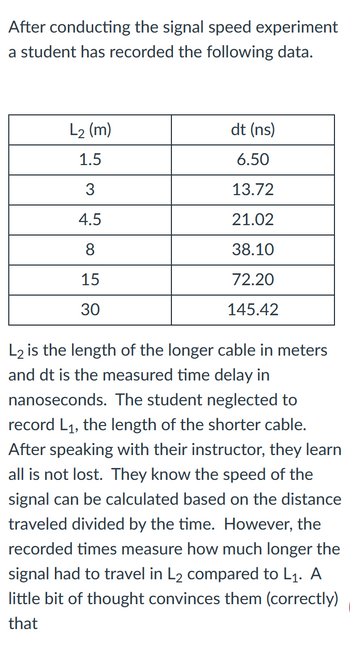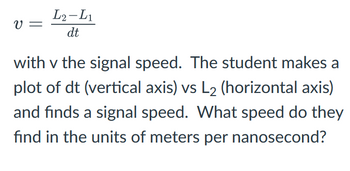Question

Transcribed Image Text:After conducting the signal speed experiment
a student has recorded the following data.
L₂ (m)
1.5
3
4.5
8
15
30
dt (ns)
6.50
13.72
21.02
38.10
72.20
145.42
L2 is the length of the longer cable in meters
and dt is the measured time delay in
nanoseconds. The student neglected to
record L₁, the length of the shorter cable.
After speaking with their instructor, they learn
all is not lost. They know the speed of the
signal can be calculated based on the distance
traveled divided by the time. However, the
recorded times measure how much longer the
signal had to travel in L2 compared to L₁. A
little bit of thought convinces them (correctly)
that

Transcribed Image Text:V =
L2-L1
dt
with v the signal speed. The student makes a
plot of dt (vertical axis) vs L₂ (horizontal axis)
and finds a signal speed. What speed do they
find in the units of meters per nanosecond?
Expert Solution
arrow_forward
Step 1
Given data:
| L2 (m) | dt(ns) |
| 1.5 | 6.50 |
| 3 | 13.72 |
| 4.5 | 21.02 |
| 8 | 38.10 |
| 15 | 72.20 |
| 30 | 145.42 |
To solve this probem, we need to consider the previous one as L1 for the next one.
For example, for L2=3 m, L1 will be 1.5 m and for L2= 4.5 m, L1 will be 3 m and so on. We need to find the corresponding dt accordingly. In the end, we need to find the average.
Trending nowThis is a popular solution!
Step by stepSolved in 2 steps

Knowledge Booster
Similar questions
- Imagine that in the measurement of 4.6 cm long metallic cylinder, your measurements in centimeters are (3.0, 3.5, 4.0, 4.5, 5.0, 5.5,6.0). What is the standard error of your length measurement. O 1.08 O 0.022 O 0.22 O 0.41 O2.22arrow_forward3 sig figsarrow_forwardI need the answer to three significant figures. That's what I'm having trouble figuring outarrow_forward
- Suppose a machine is invented to measure the amount of knowledge in a student’s head in units called “factoids.” One student is measured at F(t) = t³ − 6t² + 9t factoids at time t, where t is measured in weeks. a. Find the rate at which the student is gaining (or losing) knowledge as a function of time (be sure to give the units). b. During what time between t = 0 and 11 is the student losing knowledge? c. Sketch a graph of the function F(t).arrow_forwardAn astronomical unit (AU) is the average distance between the Earth and the Sun, approximately 1.50 × 10° km. The speed of light is about 3.00 x 10° m/s. Express the speed of light in astronomical units per minute. Number Unitsarrow_forwardAt 9:13 A.M., a sports car is traveling 30 miles per hour. Two minutes later, the car is traveling 90 miles per hour. The mean value theorem guarantees that at some time during this two-minute interval, the car's acceleration is exactly A miles per hour squared. Compute the value of A. A = mi/h² Need Help? Read Itarrow_forward
- g) 2.1*10^53 pg = ...? Tgarrow_forwardThe radius of a sphere is known to be r = 6.27 ± 0.06 cm. The volume of a sphere is given by (4/3)?r3. Find the absolute uncertainty and the percent uncertainty in the volume of the sphere. absolute uncertainty cm3 percent uncertaintyarrow_forwardThe nearest neutron star (a collapsed star made primarily of neutrons) is about 3.00 × 1018 m away from Earth. Given that the Milky Way galaxy (Fig. P1.81) is roughly a disk of diameter ~ 10²' m and thickness ~ 1019 m, estimate the number of neu- tron stars in the Milky Way to the nearest order of magnitude. Figure P1.81arrow_forward
- The extraterrestrials in an exoplanet in a distant galaxy have the following units to measure distances.1 dray = 12 elim; 1 toof = 24 dray; 1 chin = 1250 toof. a. Convert 2.4 chin to elim. __________________ elim b. The alien grows vegetables in 16.0 square dray (i.e., dray2) patch. Calculate the area of the patch insquare elim (i.e., elim2).____________ clim2arrow_forwardThe U.S. federal debt in the 2008 fiscal year was a little less than $10 trillion. Most of us do not have any concept of how much even one trillion actually is. Suppose that you were given a trillion dollars in $100 bills. If you made 100-bill stacks and used them to evenly cover a football field (between the end zones), make an approximation of how high the money pile would become. (We will use feet/inches rather than meters here because football fields are measured in yards.) One of your friends says 3 in., while another says 10 ft. What do you think?arrow_forwardIt's showing that b is not correct. Thank you for your help with this practice problem.arrow_forward
arrow_back_ios
SEE MORE QUESTIONS
arrow_forward_ios